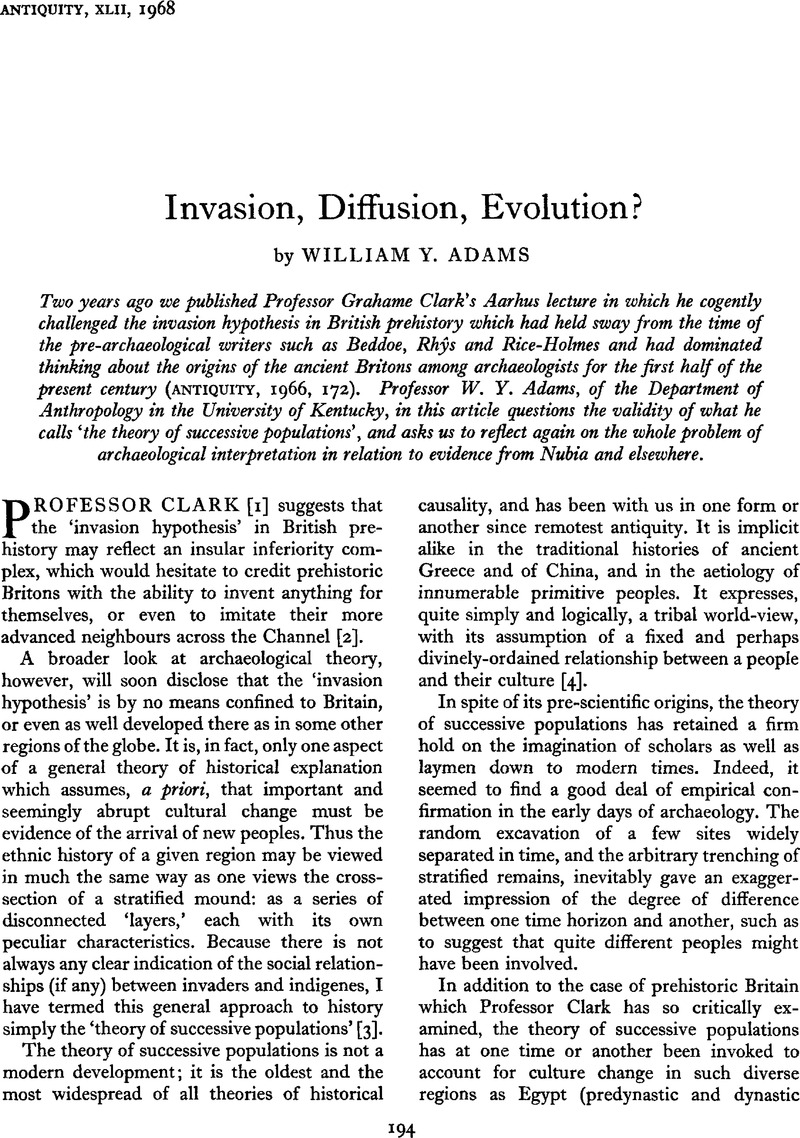Crossref Citations
This article has been cited by the following publications. This list is generated based on data provided by
Crossref.
Ucko, Peter J.
1969.
Ethnography and archaeological interpretation of funerary remains.
World Archaeology,
Vol. 1,
Issue. 2,
p.
262.
Trigger, Bruce G.
1970.
Aims in Prehistoric Archaeology.
Antiquity,
Vol. 44,
Issue. 173,
p.
26.
Daniel, Glyn
1971.
From Worsaae to Childe: The Models of Prehistory.
Proceedings of the Prehistoric Society,
Vol. 37,
Issue. 2,
p.
140.
Nicklin, Keith
1971.
Stability and innovation in pottery manufacture.
World Archaeology,
Vol. 3,
Issue. 1,
p.
13.
McNeal, R. A.
1972.
The Greeks in history and prehistory.
Antiquity,
Vol. 46,
Issue. 181,
p.
19.
Klejn, Leo S.
1974.
Regressive Purifizierung und exemplarische Betrachtung. Polemische Bemerkungen zur Integration der Archäologie mit der schriftlichen Geschichte und Sprachwissenschaft bei der ethnischen Deutung des Fundgutes.
EAZ – Ethnographisch-Archaeologische Zeitschrift,
Vol. 15,
Issue. 2,
Carlson, David S.
1976.
Temporal variation in prehistoric Nubian crania.
American Journal of Physical Anthropology,
Vol. 45,
Issue. 3,
p.
467.
Håland, Randi
1977.
Reply to comments on archaeological classification and ethnic groups.
Norwegian Archaeological Review,
Vol. 10,
Issue. 1-2,
p.
26.
SULLIVAN, ALAN P.
1978.
Advances in Archaeological Method and Theory.
p.
183.
Carlson, David S.
and
Van Gerven, Dennis P.
1979.
Diffusion, Biological Determinism, and Biocultural Adaptation in the Nubian Corridor.
American Anthropologist,
Vol. 81,
Issue. 3,
p.
561.
CHARLTON, THOMAS H.
1981.
Advances in Archaeological Method and Theory.
p.
129.
Clark, J. Desmond
1982.
The Cambridge History of Africa.
Kemp, Barry J.
1982.
The Cambridge History of Africa.
p.
658.
Cherry, John F.
1984.
The emergence of the state in the prehistoric Aegean.
Proceedings of the Cambridge Philological Society,
Vol. 30,
Issue. ,
p.
18.
Johnson, Andrew L.
and
Lovell, Nancy C.
1995.
Dental morphological evidence for biological continuity between the A‐group and C‐group periods in lower Nubia.
International Journal of Osteoarchaeology,
Vol. 5,
Issue. 4,
p.
368.
Finkelstein, Israel
1995.
Two Notes on Early Bronze Age Urbanization and Urbanism.
Tel Aviv,
Vol. 22,
Issue. 1,
p.
47.
Finkelstein, Israel
1996.
Ethnicity and Origin of the Iron I Settlers in the Highlands of Canaan: Can the Real Israel Stand Up?.
The Biblical Archaeologist,
Vol. 59,
Issue. 4,
p.
198.
Bunimovitz, Shlomo
and
Yasur-Landau, Asaf
1996.
Philistine and Israelite Pottery: A Comparative Approach to the Question of Pots and People.
Tel Aviv,
Vol. 23,
Issue. 1,
p.
88.
Bunimovitz, Shlomo
and
Yasur-Landau, Asaf
1996.
Philistine and Israelite Pottery: A Comparative Approach to the Question of Pots and People.
Tel Aviv,
Vol. 23,
Issue. 1,
p.
88.
Singer-Avitz, Lily
and
Eshet, Yoram
1999.
Beersheba – A Gateway Community in Southern Arabian Long-Distance Trade in the Eighth Century B.C.E..
Tel Aviv,
Vol. 26,
Issue. 1,
p.
3.



